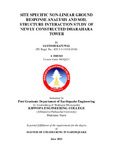Please use this identifier to cite or link to this item:
https://elibrary.khec.edu.np:8080/handle/123456789/506Full metadata record
| DC Field | Value | Language |
|---|---|---|
| dc.contributor.advisor | DR. SUBEGMAN BIJUCHHEN; DR. CHANDRA KIRAN KAWAN | - |
| dc.contributor.author | KATUWAL, SANTOSH | - |
| dc.date.accessioned | 2023-06-08T09:57:27Z | - |
| dc.date.available | 2023-06-08T09:57:27Z | - |
| dc.date.issued | 2021-06 | - |
| dc.identifier.uri | https://elibrary.khec.edu.np/handle/123456789/506 | - |
| dc.description.abstract | Nepal is located at tectonically active region of the Himalaya range, this is the main reason behind the occurance of mega shocks, therefore, earthquake disaster are inevitable in Nepal. In the recent Gorkha earthquake of magnitude 7.8Mw on 25 April, 2015, 8781 people were killed, 22,303 were injured, 6,266 public buildings were damaged and 798,897 private houses were damaged including numerious cultural heritage buildings. The Dharahara Tower is damaged by every mega shocks since it is constructed, reconstructed and repaired. In the recent Gorkha earthqake, it is collapsed completely to the first floor in which many people were killed and injured. Since the Dharahara Tower was a pride of the nation and was connected to people emotionally, therefore Government of Nepal decided to rebuild the Dharahara Tower now the construction of Dharahara Tower is completed. In this study, site specific Ground Response Analysis (GRA) and Soil Structure Interaction (SSI) study of newly build Dharahara Tower is carried out. Site specific ground response analysis is performed with the help of PLAXIS 2D; and PLAXIS 3D is used to determine the equivalent spring constant representing soil. Equivalent spring obtained from PLAXIS 3D is modeled in STAAD.Pro as spring support instead of fixed based model and result is compared accordingly. Three different cases were studied for GRA in PLAXIS 2D, they are: 1D ground response analysis, 2D ground response analysis without considering structure and 2D ground response analysis with considering structure. From the analysis result it is found that, 2D ground response analysis with considering structure produced PGA of 0.215g, while 1D and 2D free field GRA has prodeced PGA of 0.134g and 0.144g respectively from input ground motion having PGA 0.153g. The N-S component of outcroping bedrock motion recorded at Kirtipur is applied at the depth of 63m below ground surface with considering soil below this depth as engineering bedrock. In addition to ground response analysis, soil structure interaction study is carried out from combined analysis of PLAXIS 3D and STAAD.Pro. At first, Plastic analysis in PLAXIS 3D is carried out to find spring constant at each column end. Then, computed spring value is imported to STAAD.Pro for the mdoeling of spring support; and ultimately, the time history analysis is performed in STAAD.pro. For the time history analysis, acceleration time series produced at surface obtained from 2D ground response analysis with considering structure is taken into consideration. Three different cases were studied and analyzed thoroughly they are: analysis considering fixed based model, analysis without considering pile foundation and analysis with considering pile foundation. From the analysis it is found that the spring model increased vibration period as well as damping of the system as compared to fixed based model. | en_US |
| dc.language.iso | en | en_US |
| dc.title | SITE SPECIFIC NON-LINEAR GROUND RESPONSE ANALYSIS AND SOIL STRUCTURE INTERACTION STUDY OF NEWLY CONSTRUCTED DHARAHARA TOWER | en_US |
| dc.type | Thesis | en_US |
| local.college.name | Khwopa Engineering College | - |
| local.degree.name | ME Earthquake | - |
| local.degree.level | Masters | - |
| Appears in Collections: | Master of Science (M.Sc) in Earthquake engineering | |
Files in This Item:
| File | Description | Size | Format | |
|---|---|---|---|---|
| Santosh_Katuwal_2018.pdf Restricted Access | 19.15 MB | Adobe PDF |  View/Open Request a copy |
Items in DSpace are protected by copyright, with all rights reserved, unless otherwise indicated.
